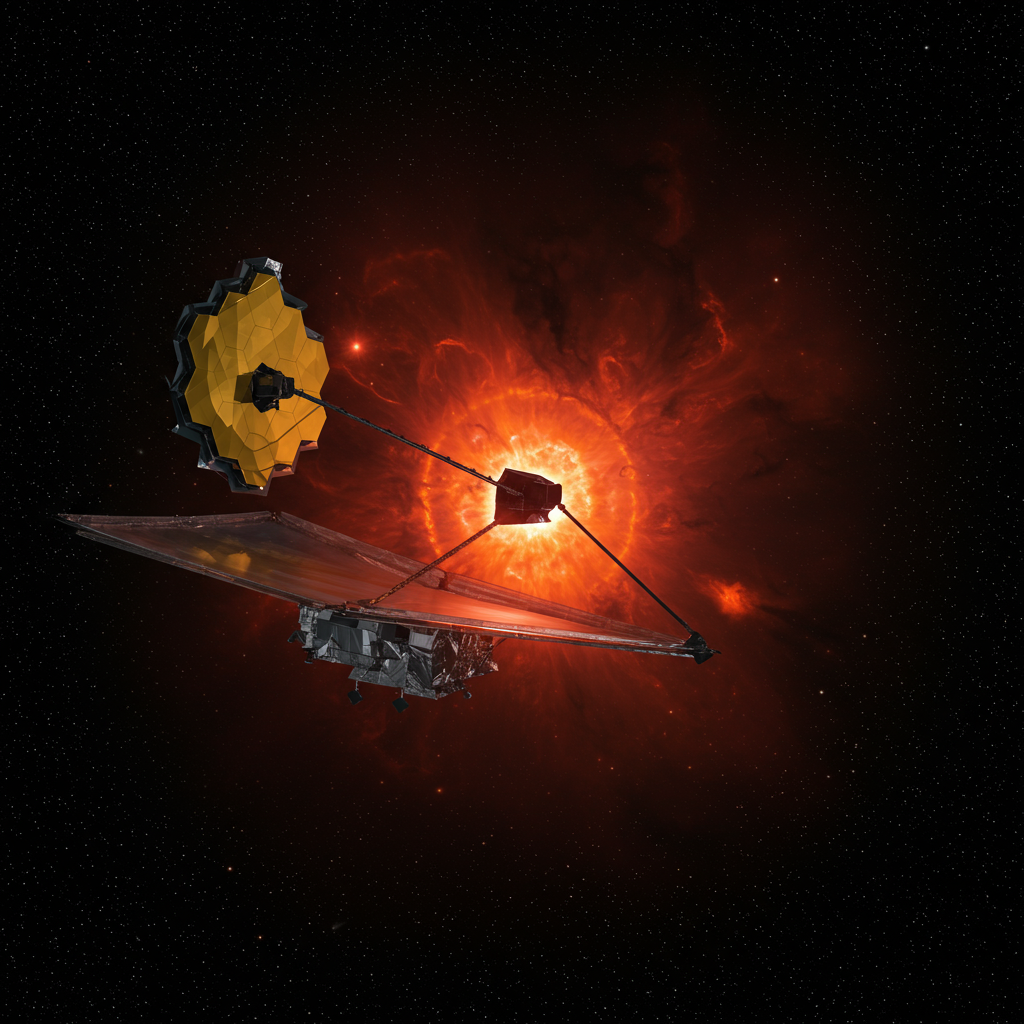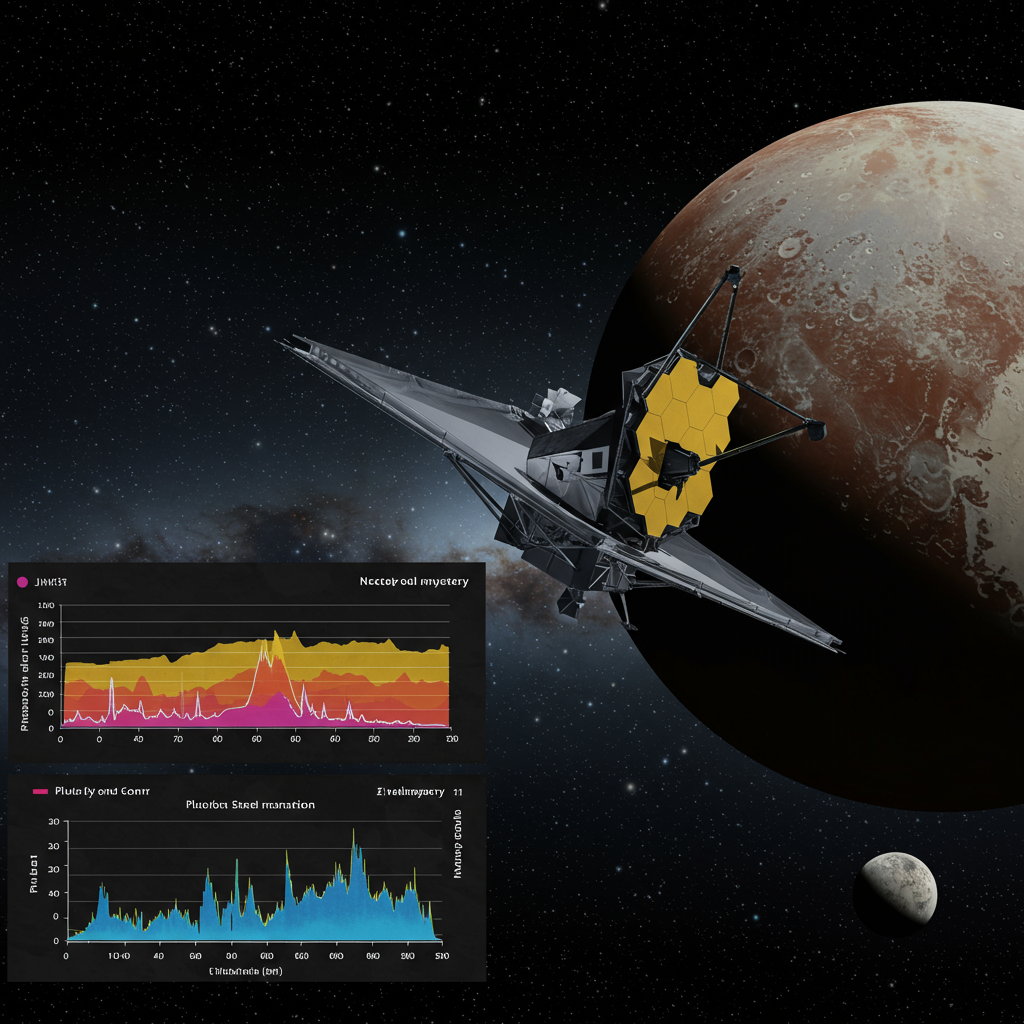The James Webb Space Telescope (JWST) has made a groundbreaking discovery, capturing an unprecedented glimpse of a massive star just before its explosive demise. This remarkable observation of a dust-shrouded red supergiant, designated SN 2025pht, is poised to resolve a long-standing cosmic enigma that has puzzled astronomers for decades. By piercing through obscuring veils of dust with its powerful infrared vision, JWST has provided compelling evidence that many “missing” supernova progenitors aren’t truly absent—they’ve simply been hidden from our view.
This pivotal finding represents the first confirmed detection of a supernova’s progenitor star by the James Webb Space Telescope. It offers profound new insights into the violent final stages of stellar evolution, bridging the gap between theoretical predictions and observational evidence. The discovery heralds a thrilling new era for astrophysics, promising to reveal the secrets of massive stars previously concealed by the cosmos.
The Enduring Mystery of “Missing” Supergiants
For generations, astronomers have grappled with a perplexing paradox regarding the most massive stars in our universe. Theoretical models confidently predict that colossal red supergiants, stars many times the mass of our Sun, should conclude their lives in spectacular core-collapse supernova explosions. However, when researchers searched for these stars in pre-explosion images, many simply weren’t there. This observational void became known as the “missing red supergiant progenitor problem.”
This discrepancy suggested a fundamental misunderstanding of stellar death or an unknown factor obscuring our view. Scientists hypothesized that thick blankets of cosmic dust might be the culprit. Such dust would absorb the visible light from these doomed stars, rendering them invisible to traditional optical telescopes like the Hubble Space Telescope. Proving this, however, required a telescope capable of seeing through this cosmic curtain.
Bridging Theory and Observation
Enter the James Webb Space Telescope. Unlike its optical predecessors, JWST is engineered to observe the universe predominantly in infrared wavelengths. Infrared light can penetrate dust clouds much more effectively than visible light, offering a unique window into previously hidden phenomena. This capability makes JWST the ideal instrument to finally test the dust obscuration hypothesis and solve the enduring mystery of the “missing” red supergiant progenitors. The recent observation of SN 2025pht serves as definitive proof, validating decades of theoretical speculation.
JWST’s Infrared Revelation: SN 2025pht
The star at the heart of this groundbreaking discovery is SN 2025pht, located in the spiral galaxy NGC 1637, approximately 40 million light-years from Earth. The supernova event itself was detected on June 29, 2025. What makes this observation so extraordinary is that JWST had already imaged this region twice in 2024, prior to the explosion.
This pre-supernova data from JWST, combined with archival images from the Hubble Space Telescope dating back to 1994, allowed a team of astronomers led by Charlie Kilpatrick of Northwestern University to meticulously pinpoint the progenitor star. They achieved this by carefully aligning the datasets using 36 common stars as reference points. This precision enabled them to identify a single, bright, point-like source in the JWST pre-explosion images that perfectly matched the later supernova site observed by Hubble.
A Star Shrouded in Secrets
What the JWST images revealed was startling. The progenitor of SN 2025pht was an exceptionally luminous star, shining roughly 100,000 times brighter than our Sun. Yet, its visible light was dimmed by more than 100 times due to an incredibly dense cocoon of dust enveloping it. This massive dust layer also absorbed shorter, bluer wavelengths of light, making the star appear extraordinarily red.
Study co-author Aswin Suresh, a graduate student at Northwestern, described SN 2025pht’s progenitor as “the reddest, dustiest red supergiant that we’ve seen explode as a supernova.” This extreme dustiness provides strong observational evidence for the hypothesis that the most massive aging stars are often also the dustiest. It directly explains why these luminous giants were largely undetectable in visible light before their explosive deaths, thereby solving the “missing red supergiant progenitor problem.” Kilpatrick further noted that this implies past supernova progenitors, lacking such high-quality infrared data, might have been significantly more luminous than previously estimated.
Unraveling the Dust’s Composition
Beyond simply confirming the presence of dust, the JWST observations offered another intriguing surprise about SN 2025pht. The composition of the circumstellar dust around this particular red supergiant was unusual. Red supergiants typically produce oxygen-rich, silicate-based dust as they shed their outer layers. However, the dust around SN 2025pht appeared to be rich in carbon.
Carbon-Rich Clues
This unique chemical signature suggests a fascinating scenario. Researchers propose that powerful convection currents deep within the star’s interior may have dredged up carbon from its core during its final years. This process would have enriched the star’s surface with carbon, altering the chemical makeup of the dust it expelled into space just before its catastrophic demise. This carbon-rich wind was unexpected for a red supergiant of this mass. This insight provides a new dimension to understanding the complex internal processes that massive stars undergo in their death throes.
A New Era for Stellar Astrophysics
The discovery of SN 2025pht by JWST is more than just a single observation; it signifies a pivotal moment in astronomy. It opens a critical new window into the life cycles and dramatic deaths of massive stars. For decades, the well-known red supergiant Betelgeuse, the bright shoulder of Orion, has been a subject of intense speculation regarding its eventual supernova. Now, with JWST’s capabilities, astronomers can begin to track more of these hidden giants in their final, dust-shrouded moments.
The quality of data provided by JWST, and anticipated from upcoming observatories like NASA’s Nancy Grace Roman Space Telescope, promises to revolutionize our understanding. These telescopes offer unparalleled resolution, sensitivity, and infrared wavelength coverage, allowing astronomers to detect and study stars previously inaccessible. Researchers expect to make discoveries that will far exceed anything observed in the past three decades, fundamentally changing our knowledge of massive stars and supernova progenitors. This is an incredibly exciting time for the study of the cosmos.
Frequently Asked Questions
What makes SN 2025pht unique among observed supernovae?
SN 2025pht is unique because its progenitor star was identified as the “reddest, dustiest red supergiant” ever seen to explode as a supernova. While intrinsically 100,000 times brighter than our Sun, its visible light was dimmed by over 100 times due to a dense cloud of dust. Crucially, this dust was found to be carbon-rich, rather than the typical silicate dust, suggesting powerful internal convection dredged up carbon in the star’s final years. This discovery, made possible by JWST’s infrared vision, solves the long-standing mystery of why many massive red supergiant progenitors seemed to “vanish” before exploding.
How did the James Webb Space Telescope pinpoint the progenitor star of SN 2025pht?
The James Webb Space Telescope (JWST) pinpointed the progenitor star of SN 2025pht through a meticulous comparison of multi-epoch observations. Researchers, led by Charlie Kilpatrick, used pre-explosion images of the galaxy NGC 1637 taken by JWST in 2024 and archival data from the Hubble Space Telescope dating back to 1994. By carefully aligning these datasets, they identified a single, bright, point-like source in the JWST infrared images that perfectly matched the precise location of the supernova observed later by Hubble. JWST’s ability to see through cosmic dust with its infrared capabilities was crucial for detecting this previously hidden star.
What does the discovery of SN 2025pht mean for future astronomy research?
The discovery of SN 2025pht marks a new era for stellar astrophysics, fundamentally advancing our understanding of massive star life cycles and supernova progenitors. It provides strong evidence that many “missing” red supergiant progenitors are simply hidden by dust, opening new avenues for detecting and studying these stars. Researchers can now use JWST and upcoming telescopes like the Nancy Grace Roman Space Telescope to track more dusty, variable stars in their final moments. This will lead to more accurate luminosity estimates for past supernovae and significantly enhance our theoretical models of stellar evolution and death, promising breakthroughs that will surpass discoveries from the last three decades.
Conclusion
The James Webb Space Telescope continues to redefine our understanding of the universe, and its latest triumph with SN 2025pht is a testament to its unparalleled capabilities. By unveiling a hidden red supergiant on the brink of a supernova, JWST has not only solved a long-standing astronomical mystery but has also provided invaluable new data on the complex processes that govern stellar death. This discovery underscores the critical importance of infrared astronomy in peering through cosmic obscuration. As JWST continues its mission, alongside future observatories, we can anticipate a future filled with even more profound revelations about the birth, life, and spectacular death of stars.




